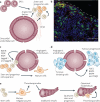Instructive role of the vascular niche in promoting tumour growth and tissue repair by angiocrine factors
- PMID: 20094048
- PMCID: PMC2944775
- DOI: 10.1038/nrc2791
Instructive role of the vascular niche in promoting tumour growth and tissue repair by angiocrine factors
Abstract
The precise mechanisms whereby anti-angiogenesis therapy blocks tumour growth or causes vascular toxicity are unknown. We propose that endothelial cells establish a vascular niche that promotes tumour growth and tissue repair not only by delivering nutrients and O2 but also through an 'angiocrine' mechanism by producing stem and progenitor cell-active trophogens. Identification of endothelial-derived instructive angiocrine factors will allow direct tumour targeting, while diminishing the unwanted side effects associated with the use of anti-angiogenic agents.
Figures



Similar articles
-
Beyond Angiogenesis: Exploiting Angiocrine Factors to Restrict Tumor Progression and Metastasis.Cancer Res. 2020 Feb 15;80(4):659-662. doi: 10.1158/0008-5472.CAN-19-3351. Epub 2019 Dec 12. Cancer Res. 2020. PMID: 31831463
-
Tumours can adapt to anti-angiogenic therapy depending on the stromal context: lessons from endothelial cell biology.Eur J Cell Biol. 2006 Feb;85(2):61-8. doi: 10.1016/j.ejcb.2005.10.003. Epub 2005 Nov 11. Eur J Cell Biol. 2006. PMID: 16439306 Review.
-
Controlling escape from angiogenesis inhibitors.Nat Rev Cancer. 2012 Oct;12(10):699-709. doi: 10.1038/nrc3366. Nat Rev Cancer. 2012. PMID: 23001349 Free PMC article. Review.
-
Two-domain vascular disruptive agents in cancer therapy.Curr Cancer Drug Targets. 2004 Sep;4(6):501-9. doi: 10.2174/1568009043332826. Curr Cancer Drug Targets. 2004. PMID: 15379635 Review.
-
Recent advances in angiogenesis, anti-angiogenesis and vascular targeting.Trends Pharmacol Sci. 2002 Dec;23(12):576-82. doi: 10.1016/s0165-6147(02)02109-0. Trends Pharmacol Sci. 2002. PMID: 12457776 Review.
Cited by
-
The perivascular niche regulates breast tumour dormancy.Nat Cell Biol. 2013 Jul;15(7):807-17. doi: 10.1038/ncb2767. Epub 2013 Jun 2. Nat Cell Biol. 2013. PMID: 23728425 Free PMC article.
-
EphA3 CAR T cells are effective against glioblastoma in preclinical models.J Immunother Cancer. 2024 Aug 7;12(8):e009403. doi: 10.1136/jitc-2024-009403. J Immunother Cancer. 2024. PMID: 39111832 Free PMC article.
-
The cancer stem cell niche: how essential is the niche in regulating stemness of tumor cells?Cell Stem Cell. 2015 Mar 5;16(3):225-38. doi: 10.1016/j.stem.2015.02.015. Cell Stem Cell. 2015. PMID: 25748930 Free PMC article. Review.
-
Infantile Hemangioma Originates From A Dysregulated But Not Fully Transformed Multipotent Stem Cell.Sci Rep. 2016 Oct 27;6:35811. doi: 10.1038/srep35811. Sci Rep. 2016. PMID: 27786256 Free PMC article.
-
Endothelial cells promote the colorectal cancer stem cell phenotype through a soluble form of Jagged-1.Cancer Cell. 2013 Feb 11;23(2):171-85. doi: 10.1016/j.ccr.2012.12.021. Epub 2013 Jan 31. Cancer Cell. 2013. PMID: 23375636 Free PMC article.
References
-
- Folkman J. Angiogenesis: an organizing principle for drug discovery? Nature Rev. Drug Discov. 2007;6:273–286. - PubMed
-
- Ferrara N, Hillan KJ, Gerber HP, Novotny W. Discovery and development of bevacizumab, an anti-VEGF antibody for treating cancer. Nature Rev. Drug Discov. 2004;3:391–400. - PubMed
-
- Carmeliet P, Jain RK. Angiogenesis in cancer and other diseases. Nature. 2000;407:249–257. - PubMed
Publication types
MeSH terms
Substances
Grants and funding
- P01 HL059312-090006/HL/NHLBI NIH HHS/United States
- R01 HL061849-04/HL/NHLBI NIH HHS/United States
- R01 HL097797-01/HL/NHLBI NIH HHS/United States
- R01 HL061849-03S1/HL/NHLBI NIH HHS/United States
- U01 HL066952-040002/HL/NHLBI NIH HHS/United States
- P01 HL059312-080006/HL/NHLBI NIH HHS/United States
- R01 HL075234/HL/NHLBI NIH HHS/United States
- R21 HL083222-01/HL/NHLBI NIH HHS/United States
- R01 HL075234-04/HL/NHLBI NIH HHS/United States
- U01 HL066952/HL/NHLBI NIH HHS/United States
- P01 HL067839-020004/HL/NHLBI NIH HHS/United States
- P01 HL072942-010004/HL/NHLBI NIH HHS/United States
- R01 HL097797-03/HL/NHLBI NIH HHS/United States
- P50 HL084936/HL/NHLBI NIH HHS/United States
- R01 HL058707-04/HL/NHLBI NIH HHS/United States
- P01 HL059312-100006/HL/NHLBI NIH HHS/United States
- P01 HL072942/HL/NHLBI NIH HHS/United States
- U01 HL066952-030002/HL/NHLBI NIH HHS/United States
- P50 HL084936-010003/HL/NHLBI NIH HHS/United States
- R21 HL083222-02/HL/NHLBI NIH HHS/United States
- P50 HL084936-030003/HL/NHLBI NIH HHS/United States
- P01 HL067839/HL/NHLBI NIH HHS/United States
- R01 HL075234-03/HL/NHLBI NIH HHS/United States
- U01 HL066952-020002/HL/NHLBI NIH HHS/United States
- R01 HL058707-03/HL/NHLBI NIH HHS/United States
- P01 HL059312-060006/HL/NHLBI NIH HHS/United States
- R01 HL097797-02/HL/NHLBI NIH HHS/United States
- R01 HL097797/HL/NHLBI NIH HHS/United States
- P50 HL084936-020003/HL/NHLBI NIH HHS/United States
- P01 HL059312/HL/NHLBI NIH HHS/United States
- R01 HL061849-03/HL/NHLBI NIH HHS/United States
- R01 HL061849/HL/NHLBI NIH HHS/United States
- R01 HL075234-02/HL/NHLBI NIH HHS/United States
- R01 HL061849-05/HL/NHLBI NIH HHS/United States
- P01 HL067839-050004/HL/NHLBI NIH HHS/United States
- P01 HL067839-030004/HL/NHLBI NIH HHS/United States
- P01 HL059312-070006/HL/NHLBI NIH HHS/United States
- P50 HL084936-040003/HL/NHLBI NIH HHS/United States
- P01 HL067839-010004/HL/NHLBI NIH HHS/United States
- R01 HL075234-01/HL/NHLBI NIH HHS/United States
- R01 HL061849-02/HL/NHLBI NIH HHS/United States
- U01 HL066952-050002/HL/NHLBI NIH HHS/United States
- U01 HL066952-010002/HL/NHLBI NIH HHS/United States
- HHMI/Howard Hughes Medical Institute/United States
- P01 HL067839-040004/HL/NHLBI NIH HHS/United States
- R21 HL083222/HL/NHLBI NIH HHS/United States
LinkOut - more resources
Full Text Sources
Other Literature Sources

